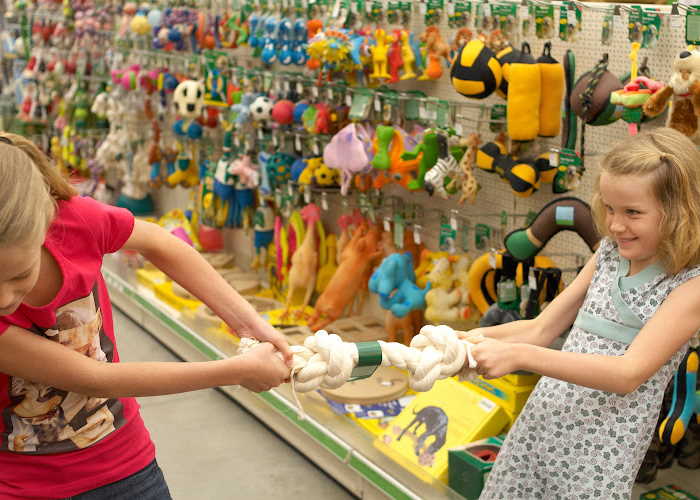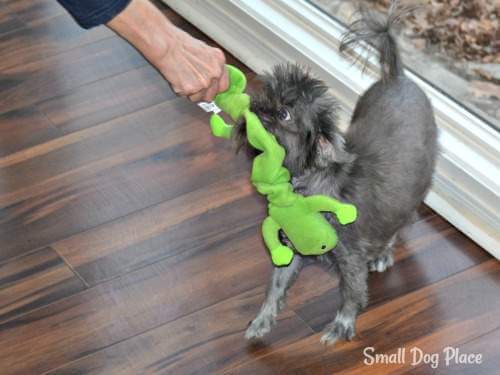- Small Dog Place Home
- Lifestyle
- Indoor Dog Games
9 Indoor Dog Games to Keep Your Pup Entertained During the Winter
Indoor Dog Games |Last Updated 03-11-2024
Do you struggle to fit a proper walk into
your schedule during the winter? Or does your pet get too cold for long walks?
If so, you’re not alone. Reduced daylight hours and cold weather mean it’s often not possible to give your pet a long walk each day. This is especially difficult if you work during the day, as it’s probably dark when you get home.
A lack of exercise can cause a variety of issues though. Aside from being important for your pet’s health, exercise reduces boredom and can prevent destructive behavior. Walks are also one of the best times to bond with your dog.
Fortunately, physical exercise isn’t the only way to tire your pup. Indoor games can provide mental stimulation to make up for shorter winter walks – plus they are great for bonding and your dog will love them.
Over the years, I’ve found the best games are those that align with your dog’s natural instincts. They also don’t just tire a dog, but provide a sense of satisfaction and achievement too. With that in mind, here are nine of my favorite games.
 Indoor Dog Games to Prevent Boredom
Indoor Dog Games to Prevent Boredom1. Indoor Dog Games: “Find It!”
One of the easiest ways to mentally stimulate your pet is to play “Find It.” This game forces a dog to use his sense of smell and tracking instincts. From personal experience, 10-minutes of “Find It” can be as mentally tiring as a short walk.
The game is simple but can provide hours of fun. Show your dog a favourite toy, then give him the “Wait” command while you hide the toy in another room. Release him from “Wait” and allow him to find the toy. Once your dog touches it, give praise and a treat.
It’s usually best to start with easy hiding places until your dog fully understands what he’s meant to do. Make sure you wait until he touches the toy before you give praise. You can gradually increase the difficulty depending on how quickly your dog finds it.
Also, if your dog doesn’t have a strong “wait” command, this is a great way to teach it in a controlled environment.
2. Indoor Dog Games: Box of Treats
A simple game is to hide treats or kibble in a few cardboard boxes. Place these around the living room and let your dog work out how to get them.
Some dogs will rip apart the boxes, while others take a more measured approach. How the dog gets the treats isn’t really important for this game. All that matters is that the dog is forced to think and come up with his own solution.
If your dog finds this too easy, you can also buy a puzzle toy. These toys force your pet to focus on a single task while using their brain to problem solve.
3. Indoor Dog Games: Trick Training
 Indoor Dog Games: Teach Him a Treat
Indoor Dog Games: Teach Him a TreatMy favourite way to mentally stimulate a dog is trick training. Any dog can learn basic tricks, and the concentration required will quickly tire them out. Trick training is also a great way to bond with your dog – but only if you use positive reinforcement methods.
Before you start trick training, however, it’s a good idea to master the basic commands. These are sit, wait, lay down and recall.
Once your dog has a solid base, there are almost endless tricks you can teach. Some simple examples include:
- Roll over
- Play dead
- Wave
- Stand from a sitting position (this is a tough one!)
- Spin
A more practical trick is teaching your dog to hold eye contact when you say their name. This is a vital skill, as you want to be able to get your dog’s attention instantly.
To teach eye contact, say your dog’s name then reward him when he looks directly into your eyes. Gradually build up from a few seconds to half a minute without breaking eye contact.
As a general rule, keep training sessions short and make them as fun as possible. Use high-reward treats and plenty of praise.
4. Indoor Dog Games: Mini Obstacle Courses
A bonus of having a small dog is that you can make a simple obstacle course in your living room.
I use a combination of small boxes, mini cones and toys to make courses. Teaching your dog to weave through cones and leap over boxes helps burn excess energy and is also lots of fun.
The great thing about this game is you can change the layout of the course each time. This keeps it fresh and interesting for your pet. It’s also a convenient way to start teaching your dog the basics of agility training.
5. Indoor Dog Games: Hide the Treat
A variation on “Find It” is to hide treats
or kibble in various locations around the house. Dogs love to use their nose –
especially when sniffing for food.
Dogs with a finely attuned sense of smell should be able to find almost any food wherever you hide it. But if your dog struggles, use a smelly treat to make the game easier.
If you’re worried about feeding your pet too many treats, you can even feed part or all of their dinner using this method. This is a useful trick if your dog tends to gulp down his meal too quickly from a bowl.
6. Make Sure You Rotate Toys
 Rotate Dog Toys
Rotate Dog ToysMost dogs love to play with toys, but they quickly get bored of the same items.
To combat this without spending a fortune on new toys, give your dog one or two to play with at a time. Rotate them for others after a few days so your pet always has something new and interesting to play with.
Even with new toys, it’s hard for a dog to play for long on his own. To provide more mental stimulation, help entertain your dog with simple games like tug-of-war or fetch.
7. Indoor Dog Games: Name His Toys
Dogs have an incredible ability to learn large amounts of words, so we can use this to our advantage when devising games.
An easy way to get your dog’s brain working is to teach him names for specific toys. This takes practice, but it’s possible to teach the name of almost endless toys if you have the patience and time.
Once your dog knows the name of a toy, you can hide it amongst other objects and get him to bring it to you. This sounds like a simple task, but most dogs find this a difficult challenge.
You can also teach your dog the names of people in the house, then get him to find them. In our household, we often play a game where one person hides, and the other tells the dog to “find [name].”
8. Indoor Dog Games: Tug of War
 Indoor Dog Games: Tug of War
Indoor Dog Games: Tug of WarOne of the simplest games to play with your dog is tug-of-war. This game has a bad reputation amongst some dog owners, but if played safely it’s a great way to tire your dog without leaving the house.
The key is to teach your dog the “give” command. This allows you to control the game and make sure it doesn’t get out of hand.
Instead of pulling until there’s a winner, play for a while then ask your dog to give. Once he lets go, you can start again. While some play-growling and vigorous pulling is fine, try to stop before your dog gets over-aroused.
9. Indoor Dog Toys: Choose the Cup
Do you know the children’s game where an adult hides an object under one of three cups before moving them around? Dogs can play this too!
Start by lining up three cups and putting a treat under one. Don’t move them around at this stage – just let your dog sniff them. When he touches the right cup, praise him and lift it up so he can eat the treat.
Before long, most dogs will start to understand they need to watch where you put the treat and then touch the right cup. You can then start swapping the cups around to make it more challenging.
Once your dog understands the game, this is a fantastic way to provide a mental challenge without needing much space.
Interactive Puzzle Toys for Dogs
Interactive Puzzle Toys are always a challenge and sometimes the game doesn't go exactly as you have planned. Still, it's fun for your dog and will definitely put a smile on your face.
Indoor Dog Games Summary
Physical exercise is vital for any dog, but
don’t overlook mental stimulation – especially during cold winter months. The
nine games in this article can keep your dog entertained while helping you
build a stronger bond with your pet. Give them a try next time it’s too cold or
dark to give your pet a long walk.
The most important thing is to make the games as fun as possible. Give your dog plenty of praise and treats – although be careful to avoid overfeeding. I often use part of my dog’s dinner as some of the rewards, but it’s a good idea to mix in high-value treats too.
Don’t get frustrated if your dog doesn’t understand the games straight away. Teaching the games is mental stimulation in itself, and it might take some dogs several sessions before they get the hang of it.
Finally, make sure you choose games that are suitable for your breed. An athletic Cavapoo, for example, might enjoy an obstacle course, but a pug would prefer trick training or a food puzzle.
I hope this article has given you plenty of ideas for keeping your dog entertained. Do you play any other indoor dog games? Or do you have a tip for mentally stimulating your pet? I’d love to hear your thoughts in the comments section!
About Janice (author and voice behind this site)
Having lived with dogs and cats most of her life, Janice served as a veterinary technician for ten years in Maryland and twelve years as a Shih Tzu dog breeder in Ohio.
Her education includes undergraduate degrees in Psychology with a minor in biology, Early Childhood Education, and Nursing, and a master's in Mental Health Counseling.
She is a lifelong learner, a dog lover, and passionate about the welfare of animals. Her favorite breed for over 50 years has been the Shih Tzu, but she has also lived with Poodles, Maltese, Yorkshire Terriers, Beagles, English Bulldogs, Carin Terriers, and a Cocker Spaniel.
When not writing, reading, and researching dog-related topics, she likes to spend time with her eight Shih Tzu dogs, husband, and family, as well as knitting and crocheting. She is also the voice behind Miracle Shih Tzu and Smart-Knit-Crocheting
Does This Article Deserve Your Thumbs Up?
We always appreciate your support and encouragement. Your thumbs up means so much to us. Please like this article.
If you find this page or any page on Small Dog Place Helpful, or useful in anyway, I'd love it if you would click the small heart found on the bottom right of each page.
You can also share or bookmark this page -- just click on the:

Free Monthly Newsletter
Sign Up for Our Free Newsletter and get our Free Gift to You.
my E-book, The Top 10 Mistakes People Make When Choosing a Dog (and how to avoid them)

